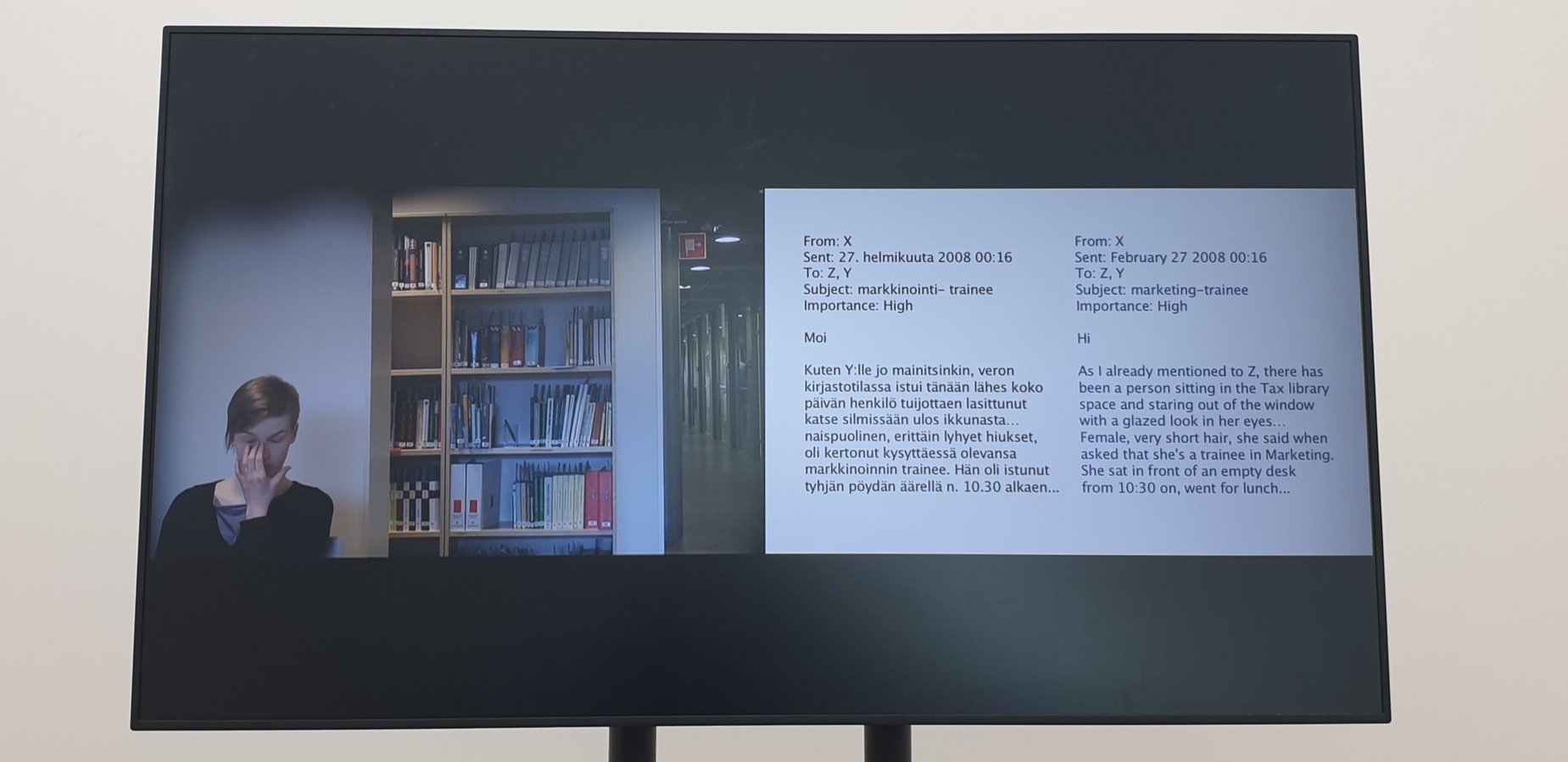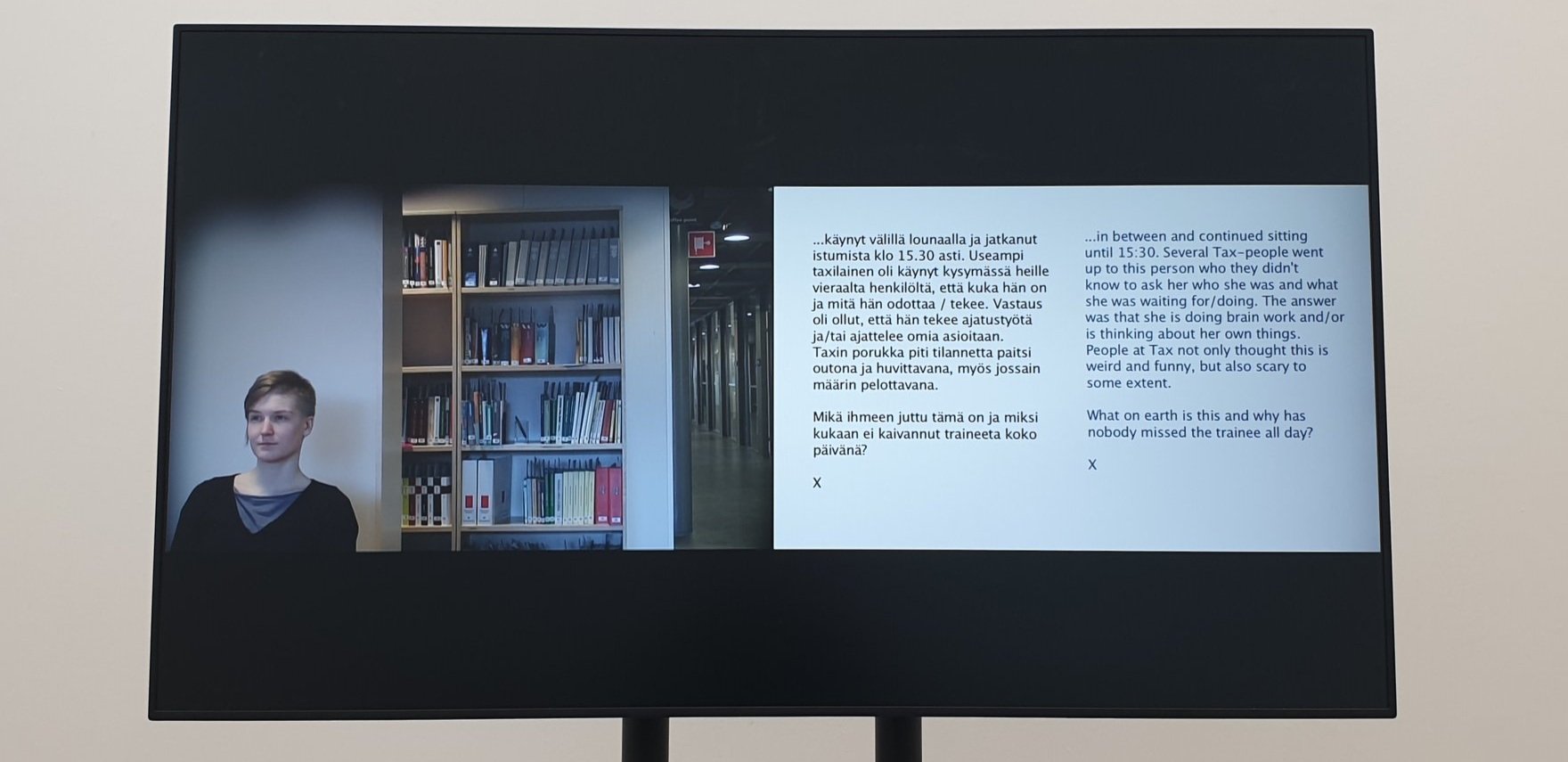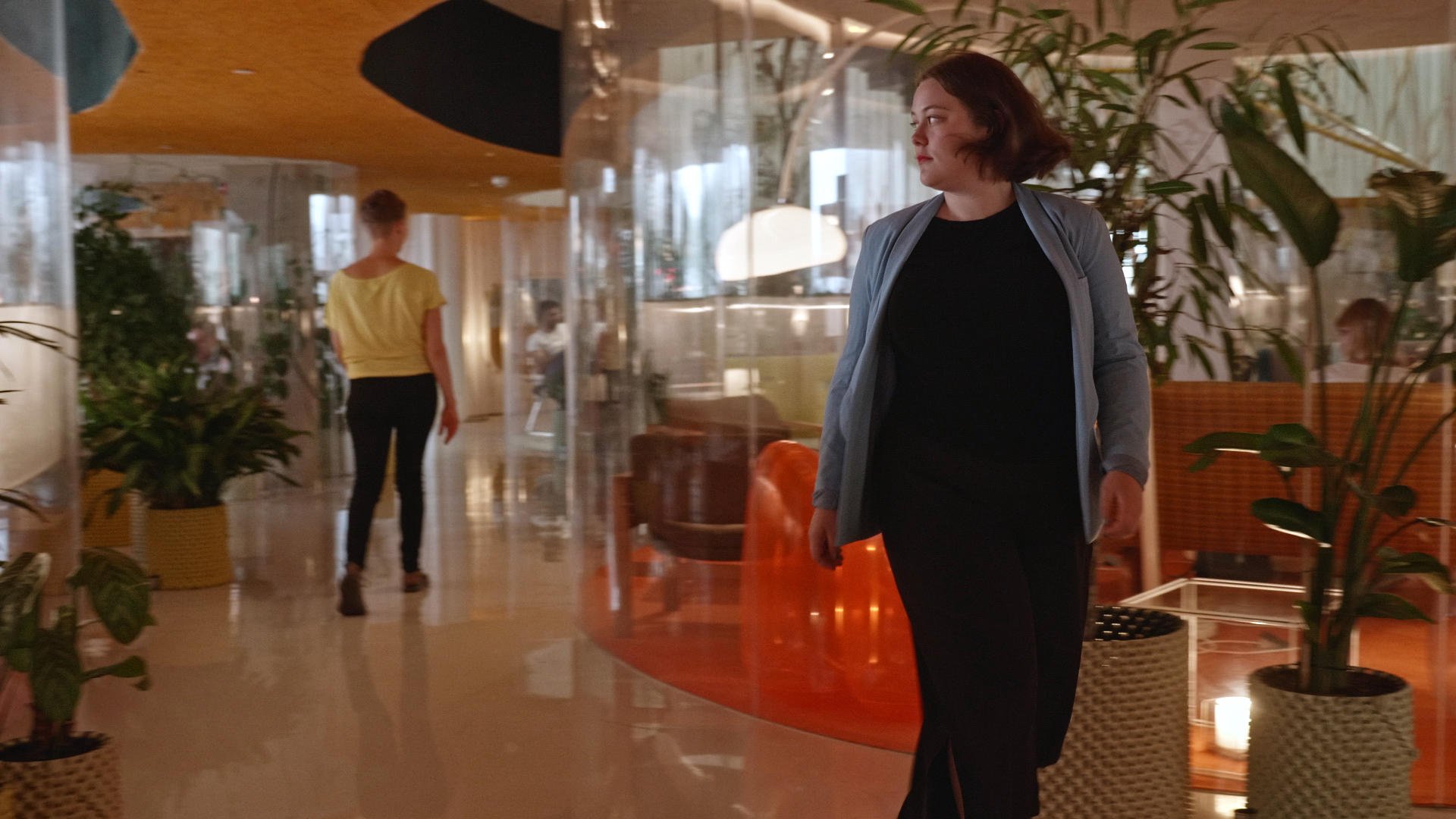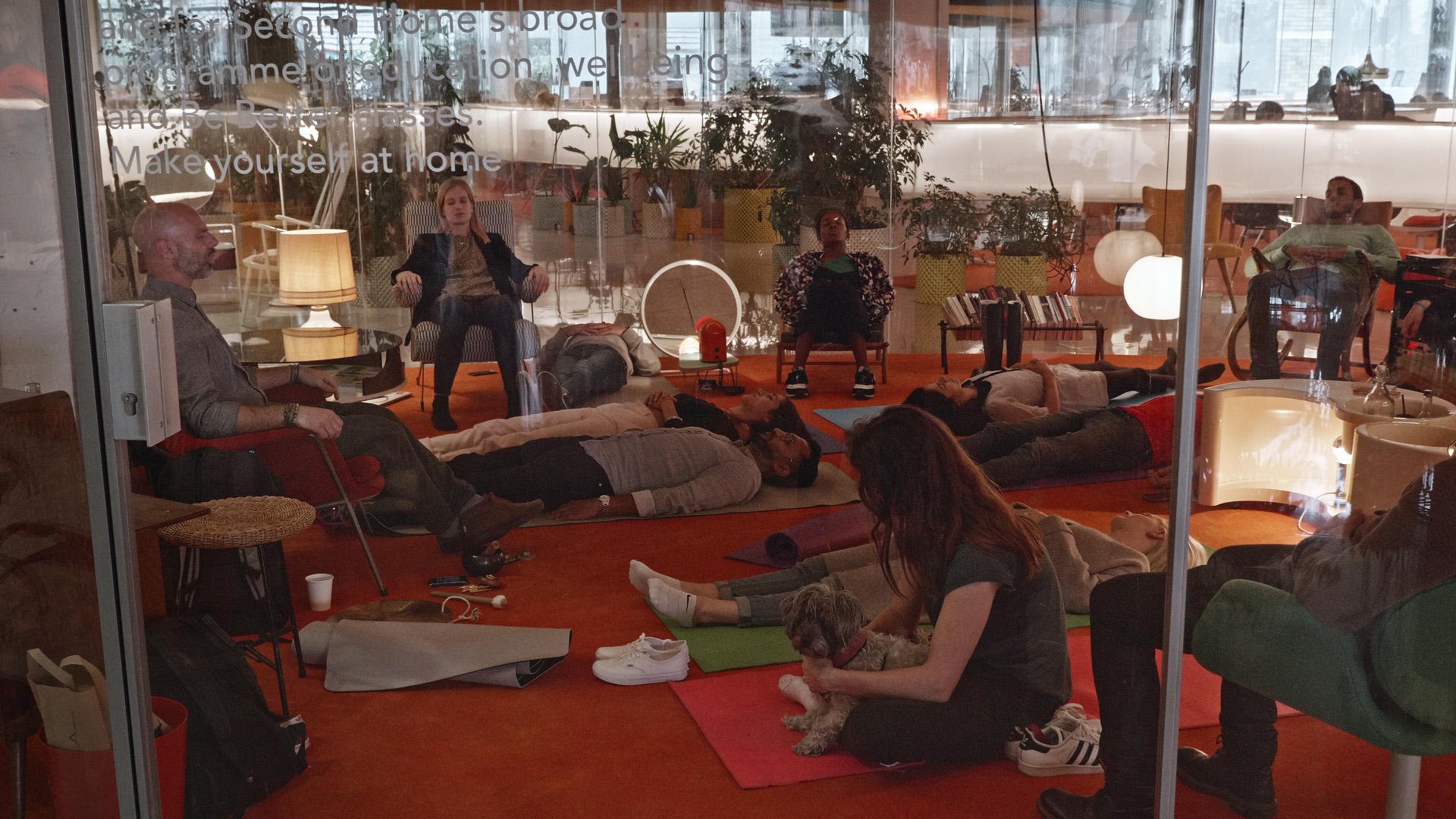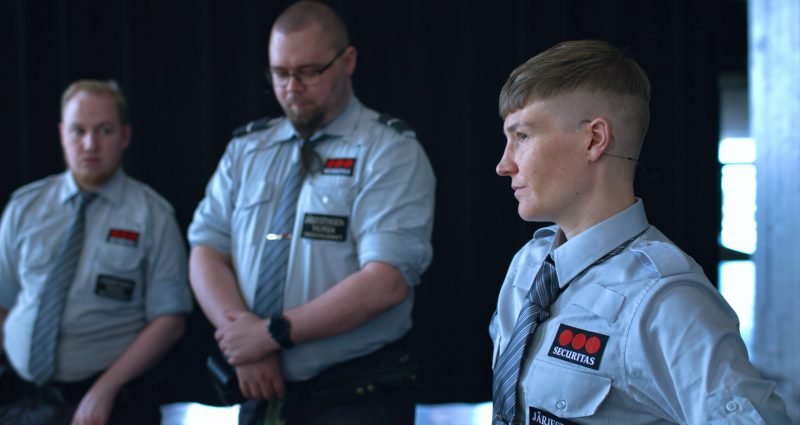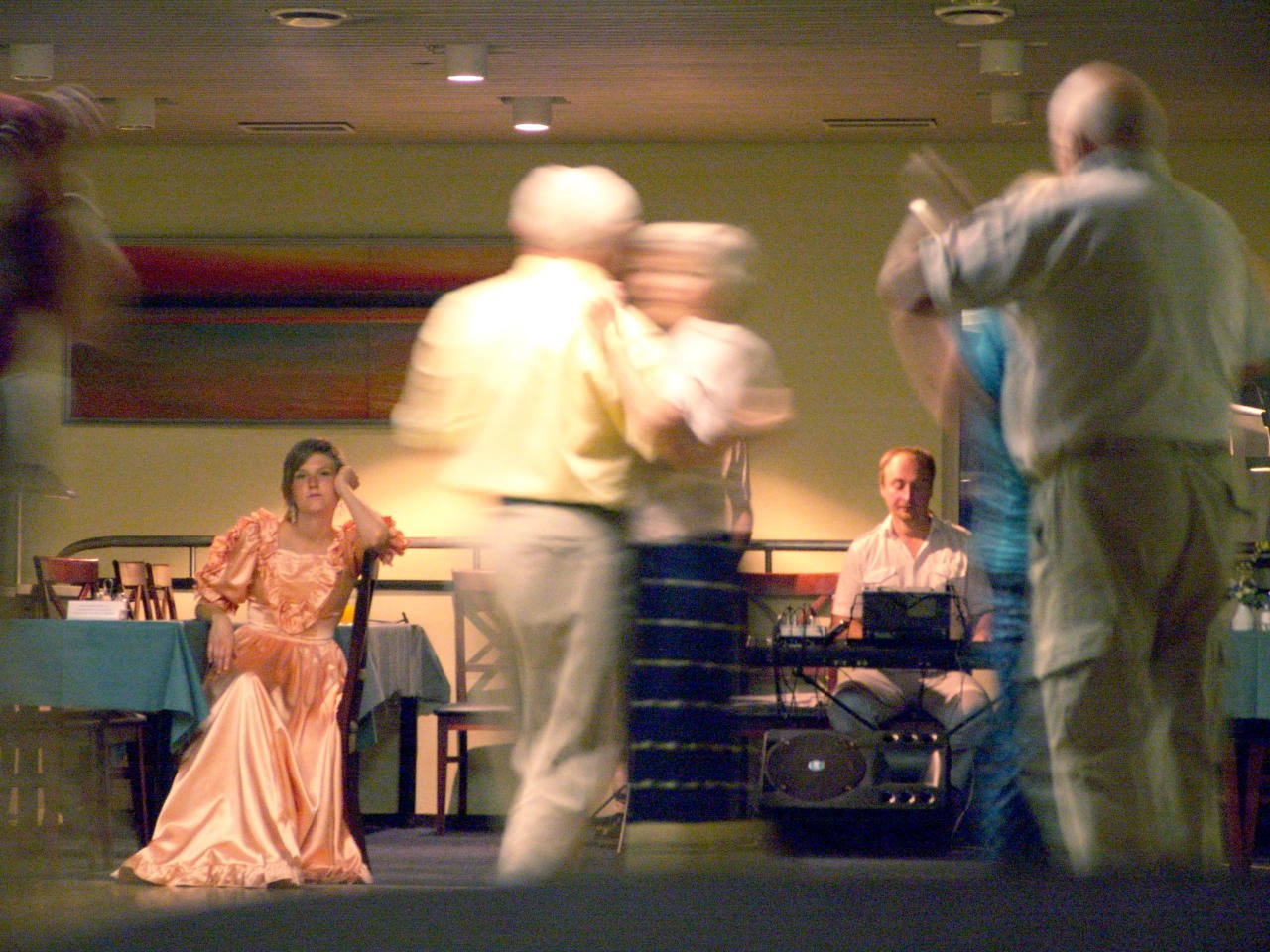Pilvi Takala: On Discomfort @ Goldsmiths CCA
Pilvi Takala’s mini-retrospective, currently on show at Goldsmiths CCA, is the perfect excuse to cross south of the river. Her practice's central theme is how a defined space influences one's behaviour and agency. What is expected and tolerated? How can individuals transgress these unwritten collective social rules?
Pilvi Takala, Workers’ Forum, 2015. 6:23 video. Courtesy of the artist.
The first video to greet visitors is Workers’ Forum (2015). The animated conversation is a compilation of exchanges with micro-taskers. In this service, the micro-taskers are passing as boyfriends and girlfriends; here, they fill a need for human connection. Based on text interaction, the discussion raises issues about the distortion of reality, stalking, mental illness and suicide. Out of the service, the subscriber/s is still inhabiting his/her/their lone reality, a fate that might be harsher. On the one hand, Takala shows the limitations of the service and how some businesses capitalise on modern loneliness and the micro-tasks/hustler economy. On the other hand, she is stretching the incapacity of the digital to replace interpersonal interactions.
Upstairs, visitors find three videos exploring how one's actions can challenge the power and social structures in three defined public spaces: the corporate office, an amusement park and a co-working space.
Pilvi Takala, The Trainee, 2008. Installation, 13:35 video. Courtesy the artist.
The Trainee (2008) takes place at Deloitte offices in Helsinki. For this experiment, undercover as an intern, Takala occupied her time doing ‘brain work’. These activities included: riding the elevator all day long; sitting at her desk; her hands still all day, with no production of any kind actively subverting the corporate office rules that every worker’s tasks should have visible and easy-to-quantify results.
Throughout the month of the experiment’s duration, Takala’s behaviour becomes increasingly unusual. Her colleagues, who were first amused by her presence, turned hostile, some found ways to cope with her peculiar actions, and others raised the issue to Human Resources, asking for clarifications about her assigned tasks, questioning her mental health, and finally being relieved when made aware that her contract is soon to terminate.
Pilvi Takala, The Trainee, 2008. Still images taken from original video. Courtesy: Eve Hard.
So why was she seen as an eyesore by some? Possibly, this was because she acted as an active manifestation of the non-essential tasks an office worker must complete on any given day. Maybe it was because she allowed herself to be visibly ‘unproductive’. Perhaps, because thinking does not require hands, it looks senile but is highly needed. Or maybe it was because she was only freely navigating the different parts of the office, thereby highlighting the socially vacuous aspect of working as part of a corporation.
Pilvi Takala, Real Snow White, 2009. 9:19 video. Courtesy of the artist.
The second video, Real Snow White (2009), takes place at Euro Disney in Paris, where Takala, dressed as Snow White, stands at the park entrance as she tries to enter. She poses as parents take pictures of her with their children, she signs autographs while she is contending with the guards and is ultimately removed from the premises. Her appearance, too similar to Disney’s approved Snow White, is seen as an unauthorised challenger that could break a code of conduct imposed on the ‘real’ Snow White ™. Furthermore, Takala could confuse the public.
Pilvi Takala, Real Snow White, 2009. Still image taken from original video. Courtesy of the artist.
Which fairytale character is the Real Snow White, Takala’s or the corporation-approved one? Perhaps the question should shift, is it because Takala is on the premises of Disney that only the corporate one can exist? Is her presence a threat to the commercially built-up (maybe, not-so) magical world of Disney? Here Takala candidly states that she believed the real one was a drawing.
Pilvi Takala, The Stroker, 2018. 15:16 video, two-channel video installation. Courtesy of the artist.
Returning to the professional setting, The Stroker (2018) takes place at Second Home, a rental co-working space in East London. In this double-screen video, Takala poses as Nina Nieminen, an entrepreneur consultant from Personnel Touch, interested in the positive impact of being touched, using only a gentle stroke on shoulders or forearms.
Takala’s gesture is received with mixed reactions, from acceptance as some workers mirror the motion and engage with her to indifference when some stay glued to their smartphones, and, at the other end of the spectrum, dodging openly rejecting the intrusion.
Pilvi Takala, The Stroker, 2018. Still images taken from original video. Courtesy of the artist.
As with The Trainee, an exchange of emails voices employees’ questions about Takala's alien presence and behaviours is present in this video installation. By acting overly friendly and over-carrying, the artist reveals that an open working space, considered by some to be forward-thinking, is still a fragmented space in which personal freedom is coveted and established social working conditions are still at play. Changes can happen only gradually with time.
Across all three videos, Takala actively tests daily spaces. Her actions can be seen as subversion, making visible how our behaviours are coded, codified, and culturally directed - a set of rules unknowingly internalised.
Left: Pilvi Takala, Close Watch, 2022. Still taken from original video. Courtesy of the artist.
Right: Pilvi Takala, Wallflower, 2006. Still taken from original video. Courtesy of the artist.
Downstairs two pieces explore the concept of the groups, an early work from 2006, Wallflower, and the recent 2022 Venice Biennial installation, Close Watch.
Pilvi Takala, Wallflower, 2006. 10:35 video. Courtesy of the artist.
In Wallflower, Takala is dressed in a sheer and audacious ballgown, sitting calmly, waiting patiently to be invited to dance and watching others enjoying themselves. The dancers are well aware of her ghostly presence, peeking at her, chatting about her but not inviting her. Takala is both included in space but excluded from a community -because of her age, novelty, difference and aloneness. Only as the ball concludes, after almost all the participants have exited, her long marathon-of-boredom-testing-senior-kindness is finally rewarded in the first video, one old gentleman invites her to dance, and, in the second video, a group of old ladies invites her to join the conga line.
Pilvi Takala, Close Watch, 2022. 1:07:73 video, three-channel video installation. Courtesy studio international on Vimeo.
Close Watch is a project which requires longer and more intensive involvement. She receives mandatory training to qualify for her role and works for Securitas, a security company, as a guard at one of Finland's largest shopping malls.
During her six months of employment, she is immersed in the conditions and working culture of the private security industry. Whilst there, she was confronted by racial bias, power structure, unnecessary intimidation and use of force. Tracking and keeping notes of her daily activities, she reports the issues to the CEO. Additionally, post-employment, she invites a few of her colleagues to join a workshop examining these situations and ideating solutions. During the three-day seminar, various incidents and issues are re-enacted using the format of Forum Theater. Then, less under pressure, her colleagues distanced from their work are exposed to their past actions, discuss and enumerate ways to defuse the episodes.
For example, instead of pushing a drunk person out of the toilet, the guard can politely ask how this person's day is, gently hold her arm and escort her towards the exit while chatting. Here violence is replaced by personal interaction, which creates connection and demonstrates acceptance and value in the otherness. Other recurring issues include the need for more time, constant pressure and the monotonous aspect of the work. Takala raises several questions, the primary and most important being: are these a result of the nature of the job or our overly policed world?
The visitors view the situation and understand the guard’s perspectives via the artwork installation. Visitors who watch the video in the control room are complicit. They are confronted with questions regarding where they stand. Are they an observer or a challenger?
Pilvi Takala, Close Watch, 2022. Installation shot at Goldsmith CCA. Courtesy: Eve Hard.
Takala interrogates social codes in defined and recognised situations, spaces, and roles throughout her exhibition and works. She asks us to consider our agency in the spaces, situations and world we inhabit and, ultimately, how to challenge these.
Where does discomfort begin as we move from established conventions? And why discomfort? Visitors should remember these questions when they visit the exhibition and, crucially when they negotiate and challenge their position in the World or emancipate themself from conventions.
Pilvi Takala: On Discomfort is on display at Goldsmiths CCA until June 4, 2022.
Eve Hard
Contributing Writer, MADE IN BED


